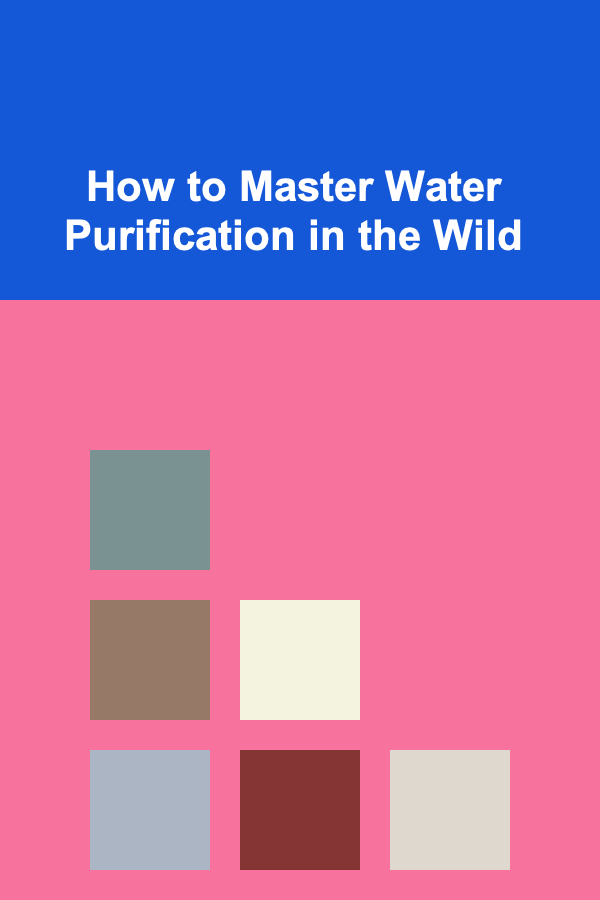
How to Master Water Purification in the Wild
ebook include PDF & Audio bundle (Micro Guide)
$12.99$9.99
Limited Time Offer! Order within the next:

Surviving in the wild requires many skills, but one of the most crucial is mastering the art of water purification. Water is essential for life, and in outdoor environments, where sources may be contaminated or scarce, having the knowledge and tools to purify water is vital. This guide will take you through the process of mastering water purification in the wild, from understanding water contamination to choosing the best purification methods for different scenarios.
Understanding Water Contamination
Before we delve into purification methods, it's essential to understand the types of contaminants commonly found in wild water sources.
1.1. Microbial Contaminants
Microbial contaminants are by far the most common in natural water sources. These include bacteria, viruses, and protozoa, which can cause a range of illnesses from mild gastrointestinal discomfort to life-threatening diseases. Common culprits include:
- Bacteria : Examples include E. coli and Salmonella, which are often found in water contaminated by animal or human waste.
- Viruses: Viruses such as norovirus or hepatitis A can be transmitted through contaminated water.
- Protozoa : Parasites like Giardia and Cryptosporidium can survive in water and cause severe stomach cramps, diarrhea, and dehydration.
1.2. Chemical Contaminants
In some situations, water can be contaminated by chemicals that are difficult to filter out using basic purification techniques. These contaminants can come from agricultural runoff, industrial pollution, or natural sources such as mineral deposits.
- Pesticides and Herbicides: These chemicals can seep into groundwater or surface water and are highly toxic to humans.
- Heavy Metals: Elements like lead, mercury, and arsenic can leach into water from industrial waste or contaminated soil.
- Industrial Chemicals: Some water sources may be tainted with solvents, detergents, or oils.
1.3. Sediment and Particulates
In addition to biological and chemical contamination, water can contain physical impurities like dirt, sand, and other debris. These particles may not be harmful in themselves but can clog filters and make water taste unpleasant. They can also harbor microorganisms.
Methods of Water Purification
Now that we understand the types of contaminants that may affect water, let's explore the most effective methods for purifying water in the wild. There are several different techniques that can be used depending on the situation and the available resources.
2.1. Boiling
Boiling water is one of the most straightforward and effective methods of purification, especially when it comes to killing microorganisms like bacteria, viruses, and protozoa. Boiling ensures that the water reaches a temperature high enough to destroy harmful pathogens.
Steps to Boil Water:
- Collect water from a natural source.
- Bring the water to a rolling boil and maintain the boil for at least 1-3 minutes, depending on the altitude. At higher elevations, the boiling point of water is lower, so it's essential to boil for longer.
- Let the water cool before drinking.
2.2. Filtration
Filtration is another popular method of water purification, especially for removing particulates, sediment, and some bacteria. There are various types of filters available, from basic cloth filters to advanced portable filters.
Types of Filters:
- Cloth Filtration: In a survival situation, a simple piece of cloth can act as a rudimentary filter. You can use it to strain out larger particles and sediment.
- Ceramic Filters: Ceramic filters are more effective at removing bacteria and protozoa. They are often combined with activated charcoal to remove some chemical contaminants.
- Portable Water Filters: Modern portable filters, like those made by brands such as Katadyn and Sawyer, are designed to filter out bacteria, protozoa, and even some viruses. They are lightweight and ideal for hiking and backpacking trips.
Steps to Filter Water:
- Collect the water and pour it through a filtration device.
- Ensure that the filter is designed to remove the specific contaminants you are concerned about, such as bacteria or protozoa.
- Drink directly from the filtered container or store the purified water in a clean container.
2.3. Chemical Purification
Chemical purification involves adding certain chemicals to water to kill pathogens. This method is widely used in emergency situations when other purification methods are not available.
Common Chemicals Used:
- Iodine Tablets : Iodine is effective at killing bacteria, viruses, and protozoa. It comes in tablet or tincture form. However, it is not very effective against some parasites like Cryptosporidium, and prolonged use can lead to thyroid problems.
- Chlorine Tablets: Similar to iodine, chlorine tablets are effective against bacteria and viruses but may not work against some protozoa. They are easy to carry and use in the field.
- Bleach: Household bleach can be used as a disinfectant. To use bleach for water purification, add 2-4 drops of unscented bleach per liter of water, mix thoroughly, and wait 30 minutes before drinking.
Steps for Chemical Purification:
- Add the appropriate amount of iodine, chlorine, or bleach to the water.
- Stir or shake the water to ensure the chemical is well-distributed.
- Wait for the required time (usually 30 minutes) to allow the chemical to kill the pathogens.
- If necessary, filter the water to remove any residual chemicals.
2.4. Solar Disinfection (SODIS)
Solar disinfection is a passive method of purifying water using sunlight. It is an ideal method when you have limited resources and no access to boiling water or chemical purifiers. Solar disinfection involves placing clear plastic bottles of contaminated water in direct sunlight.
Steps for Solar Disinfection:
- Collect the water and place it in clean, transparent plastic bottles.
- Ensure the bottles are exposed to full sunlight for at least 6 hours. In cloudy conditions, the process may take longer.
- After the required exposure time, the water is safe to drink, as the UV rays from the sun kill the pathogens.
2.5. Distillation
Distillation is an effective method for purifying water when you need to remove both biological and chemical contaminants. It works by evaporating the water and then condensing the vapor back into liquid form. This method can remove most types of contaminants, including salts and heavy metals.
Steps for Distillation:
- Collect the contaminated water in a pot or container.
- Set up a distillation apparatus by placing a clean container inside the pot to catch the purified water.
- Heat the water until it begins to evaporate. As the steam rises, it will leave contaminants behind.
- The condensed vapor will drip into the clean container, leaving behind purified water.
Considerations for Specific Environments
While the above purification methods are effective in most situations, different environments present unique challenges when it comes to sourcing and purifying water. Here's a look at some considerations based on the environment you find yourself in.
3.1. Wilderness and Forested Areas
In wooded areas, water can often be found in streams, rivers, or lakes. While these sources may appear clean, they can be contaminated with microorganisms or chemicals. Filtering and boiling are particularly effective in these environments.
- Look for flowing water: Running water is generally cleaner than stagnant water, as it is less likely to contain high levels of bacteria or pathogens.
- Avoid water near human activity: Be cautious of water near campsites, trails, or agricultural areas, as these may be contaminated with human waste or chemicals.
3.2. Desert and Arid Environments
Water in desert environments is often scarce, and the sources that do exist can be highly contaminated with salts and other chemicals. If you find yourself in such an area, it's important to know how to handle salty or brackish water.
- Distillation: This is one of the best methods for purifying water in the desert, as it can remove both biological and chemical contaminants.
- Solar Disinfection: If you have clear plastic bottles, solar disinfection can be a useful method for purifying water when other options are unavailable.
3.3. High Altitude and Mountainous Regions
Water in high-altitude areas is often cold and may come from melting snow or glaciers. These sources are typically low in contaminants but can still harbor pathogens. Boiling and filtration are often sufficient, but keep in mind that boiling time may need to be extended at higher altitudes.
- Consider the altitude: At higher altitudes, the boiling point of water is lower, so you may need to boil water for longer to ensure purification.
Conclusion
Mastering water purification in the wild is a fundamental skill that can mean the difference between life and death. Whether you're hiking in the forest, exploring the desert, or trekking through the mountains, knowing how to purify water using methods like boiling, filtration, chemical treatment, and solar disinfection can keep you safe from harmful contaminants. Remember, always prioritize water purification in any survival situation, and equip yourself with the necessary tools and knowledge to handle whatever nature throws at you. With these skills, you can confidently tackle any adventure, knowing that you can always secure safe drinking water in the wild.

How to Create a Lease Agreement That Protects Both Parties
Read More
How to Handle Security Concerns for Multi-Story Homes
Read More
How to Save Money for Retirement While Paying Off Debt
Read More
How to Set Up a Customer Appreciation Campaign: A Checklist for Building Stronger Relationships
Read More
Investment Analysis Roadmap: Essential Skills for Financial Analysts
Read More
The Ultimate Guide to Cutting Down on Alcohol and Dining Out Expenses
Read MoreOther Products

How to Create a Lease Agreement That Protects Both Parties
Read More
How to Handle Security Concerns for Multi-Story Homes
Read More
How to Save Money for Retirement While Paying Off Debt
Read More
How to Set Up a Customer Appreciation Campaign: A Checklist for Building Stronger Relationships
Read More
Investment Analysis Roadmap: Essential Skills for Financial Analysts
Read More